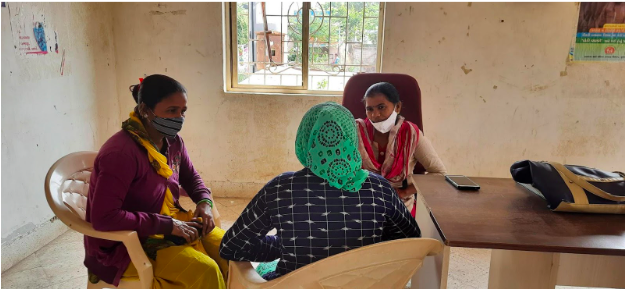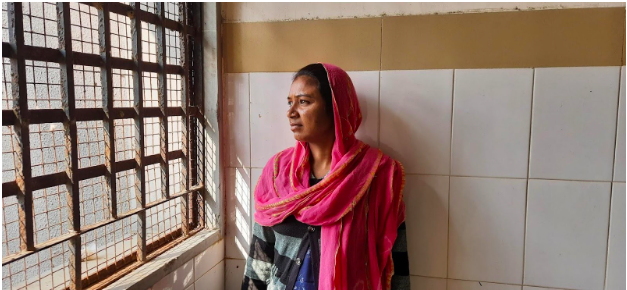Why Only 1 In 10 Survivors Of Domestic Violence Seeks Justice

Every third married woman in India faces spousal violence but only one in 10 seeks any help, says a 2020 study published in the BMJ. Worse, only 1% reported it to the police or healthcare personnel.
The number of women seeking help for domestic violence has declined from 24% to 14% in the decade to 2015, according to the National Family Health Survey-4, the latest available dataset. In these cases, women mostly sought help from their own families (65%), their husbands’ family (29%), friends (15%) or a religious leader (2%). Only 3% sought help from the police and only 1% from a medical personnel, lawyer or an non-governmental organisation.
One reason why women do not report spousal abuse is because it has been normalised – 52% women and 42% men think it is acceptable for a man to hit his wife “under certain circumstances”, the survey reported. Women seek help only when the violence turns severe and for those who approach the police and judiciary, the road to justice is long and tough.
In the first of this three-part series on gender based violence, we looked at how the public health system can support women facing domestic violence. In the second, we reported on the role community health workers can play in the crisis. In this, the final part of the series, we look at the challenges women face when they want to leave an abusive marriage and seek justice and redressal. These challenges are both social as well as systemic.
Social, economic pressures
Women who have returned to their parental home in the face of domestic violence are often cajoled or pressured into returning to their husbands, we found while reporting in rural Patan. The reasons are social as well as economic.
Many women who sought help at Mahila Sahayta Kendra, a crisis intervention and support cell at the health centre, said they could not live with their parents as they were old and could not support them. There are also cases where a brother and the sister-in-law end up supporting a survivor and her children but then this creates often uncomfortable situations.
Often a survivor does not want to return to her husband but her family is keen that she does. “We counsel the woman, her family and then register a case in the court but when the date for the case comes, the community comes together and sends her back,” said Pragya Parmar, counsellor at the Mahila Sahayta Kendra, Dharpur.
Bhavana Sompura, an advocate who has worked with a few survivors from the centre in Sidhpur, reports that the lack of financial resources often keeps women tied to abusive marriages. “So we file their application for maintenance,” she said. A woman can seek maintenance from her husband for herself and her children under the Protection of Women from Domestic Violence Act (PWDVA), 2005.
Often as the court is about to pass an order on a monthly maintenance for the survivor and her children, the husband convinces her to return home to avoid paying the maintenance, as we found in the case of Madinaben in the first part of the series. But the violence resumes. “So the husband takes the woman back and keeps her well for a few months till she withdraws the case. After that, he usually goes back to his violent ways,” said Jashoda Rana, counsellor at Mahila Sahayta Kendra in Radhanpur. “When women make emotional decisions, they end up suffering a renewed cycle of violence.”
The police prefer ‘samjhauta’
The section frequently used in the case of domestic violence is Section 498A of the IPC that provides for the prosecution and punishment of the husband or his relatives for cruelty against the woman. It is a non-bailable offence where only a magistrate can grant bail but there have been some changes: the Supreme Court of India put an end to “automatic arrest” for domestic abuse because of alleged misuse of the section. After amendments in 2018 and 2019, the police officers are asked to decide on the arrest.
The police are reluctant to file a first information report (FIR) based on a woman’s complaints alone, counsellors told us. They believe that women will face prolonged hostility for daring to make an official complaint. “If the woman files an FIR against the whole family, they will all turn against her and the case will drag for 1-2 years,” said J R Rabari, police inspector at Radhanpur. The police first visit the house of the aggrieved woman, enquire in the neighbourhood about the violence and then file an FIR, he said.
The police do everything in their power to “settle” issues between the two parties, especially if children are involved, “Sabse accha samjhauta hota hai, [a settlement is the best solution],” Rabari said. This tendency to push for mediation often hurts a survivor’s case – the police often call her in-laws and community leaders and pressurise the woman to not file an FIR, said counsellor Rana.
‘Section 498A not used often enough’
The number of pending cases under Section 498A have doubled in the 13 years to 2018, with an increase of 10% every year, as per an analysis by Factly, the data journalism website. The rate of conviction under the section too has been falling when compared to other IPC crimes: for domestic violence the conviction rate in 2006 was 21.9% and this fell to 13% in 2018; for other IPC crimes, the conviction rate increased from 42.8% in 2006 to 50% in 2018.
Behanbox’s analysis of the latest crime records show that of the 74,030 cases under Section 498A in 2020, only 1199 went to trial, 2,260 were disposed of by the court and a majority of the cases (96.9%) remained pending. Of the cases that went on trial, in 253 (21.1%), the accused were convicted and in 785 (65%), they were acquitted.
Does the high number of acquittals mean the cases were false or the section misused? “I don’t think the law is misused, I think it is not used enough,” said Flavia Agnes, lawyer and co-founder of Majlis Legal Centre that provides legal services to women . Given how rampant domestic violence is, the number of complaints is miniscule, she pointed out.
“In rural areas, very few women go to the police, it is only middle class women in cities who complain against husbands and their in-laws,” Agnes said. The low conviction rate does not mean false cases but it is because women changed their statements during the trial either to get a divorce or secure their children’s custody through negotiation, she said.
A 2012 analysis of over 100 cases filed under section 498A in Uttar Pradesh by Humsafar, the Lucknow based non-profit, showed that most women suffered domestic violence for an average of around two years before filing a complaint.
On average, it took six months for the police to register an FIR before they attempted to forge a “reconciliation”. The report noted that the police and counsellors posted in the police station did their best to dissuade the women from filing a complaint. Also, most offenders got bail within a week of their arrest even if they had inflicted serious wounds.
Even at the trial phase, 69 out of 105 cases were pending and among 36 on trial only two led to convictions. Delays were caused by attempts at mediation, poor investigation and prosecution and withdrawal of cases by women tired of the long delays.
Of the 35 cases referred for mediation, 21 led to a compromise. This demonstrates that efforts are made at every step for a reconciliation; even in cases where arrest was immediately necessary, enforcement agencies attempted a mediation, the report noted.
Delayed maintenance payment
If a woman walks out on her husband over domestic violence, she needs to first file for maintenance under the PWDVA. Then the trial starts with the accused being sent notice and asked for a response and then the magistrate passes the order. The survivor also has to file an application to receive the maintenance. Sometimes it takes six months to two years for the amount to be sent to her. The husband may also not appear and ask his lawyer to seek an extension. Things move fast when the magistrate files an ex-parte order (in the husband’s absence) which is allowed under the Act.
“It is a struggle to get maintenance, it takes 1-2 years sometimes. The judge in our [Sidhpur] court tries to pass an order in 9 months and also passes ex-parte orders but some other judges take time and women have to wait,” said Arti Prajapati, counsellor at the Mahila Sahayta Kendra in Sidhpur Hospital.
It is this waiting that wears down survivors. “Many clients do not understand there are limitations to the court process. They think once the case is on, they will receive money. This doesn’t happen and they get very disappointed,” said advocate Sompura. With court work disrupted by COVID-19, there have been even bigger delays in the passing of orders.
As a law, the PWDVA is great but there are problems with the implementation framework. “There are no judges, no protection officers and even legal aid doesn’t work as it should,” said Flavia Agnes.
Troubled reconciliation
A reconciliation encouraged by a court or the police often does not improve a marital relationship and women who are persuaded to withdraw cases often continue to face violence, according to studies.
A 2015 study on Section 498A cases conducted by the Tata Institute of Social Sciences in two districts and two cities of Rajasthan and Gujarat found that most women who had filed a complaint did it to seek a non-violent reconciliation with their husbands and in-laws. Per police records, as an outcome of their intervention, 84.1% of complainants had reconciled with their husbands, in 11.6% cases the couple had separated and and only in 4.3% the couple agreed to a divorce through mutual consent.
On interviewing the women after a year and half of their cases being closed, researchers found that 58.9% women had divorced or separated from their husbands. The rest were either widowed, had filed for divorce or gone to parental homes. Only 16 couples had actually resumed their marriage and 9 of them still reported violence. “This shows that most of the women have not been able to negotiate a non-violent reconciliation which was their reason for filing the complaint,” the researchers noted.
New beginning

After her first husband died, Jyotsnaben married for the second time. Her second husband was not violent towards her but he stopped taking responsibility for her. He also had an extra-marital relationship. Frustrated, she and her son went to her parental home but her brother-in-law convinced them to return. “He did it only because there was societal pressure. Once I was back, I was told to find my own earnings,” Jyotsnaben told BehanBox.
What really bothered her was how her husband visited her whenever he wanted to and expected her to cook for him. Jyotsnaben was referred to the Mahila Sahayta Kendra by her relative who worked as a nurse. After counselling, she decided to divorce him and told her husband that their son was his responsibility.
She returned to her village but did not stay with her parents to save them anxiety and expenses. She now works as a farm labourer and her 15-year-old son has joined her. “Coming here [Mahila Sahayta Kendra] I felt hope and courage,” Jyotsnaben said. Despite being uneducated, she managed to apply for new government documents for herself after her in-laws refused to give her documents back. She has even managed to save for a better future. “I am very happy, I work hard and I am not dependent on anyone,” she said.
This reportage is part of the SWATI and BehanBox fellowship on rural health sector response to gender based violence in Gujarat.
This is the third and final part of the series. Read the first and second parts here and here.
We believe everyone deserves equal access to accurate news. Support from our readers enables us to keep our journalism open and free for everyone, all over the world.

